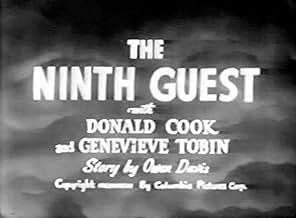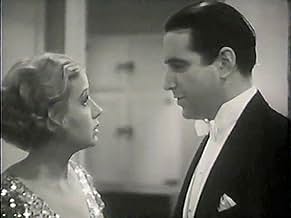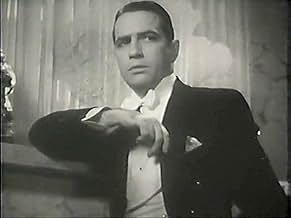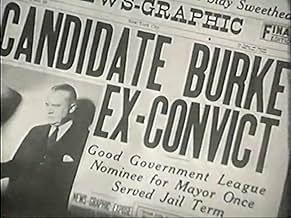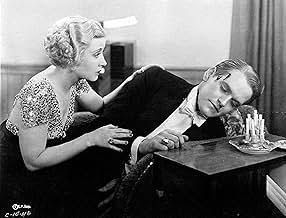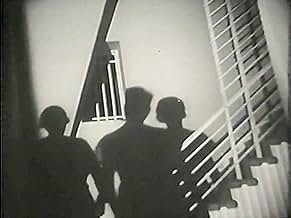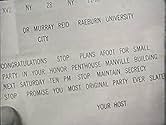Eight people are invited to dinner in a fashionable penthouse apartment. After they are wined and dined, a voice on the radio informs them that they will be murdered unless they manage to ou... Read allEight people are invited to dinner in a fashionable penthouse apartment. After they are wined and dined, a voice on the radio informs them that they will be murdered unless they manage to outwit the ninth guest: Death.Eight people are invited to dinner in a fashionable penthouse apartment. After they are wined and dined, a voice on the radio informs them that they will be murdered unless they manage to outwit the ninth guest: Death.
Vince Barnett
- William Jones
- (as Vincent Barnett)
Samuel S. Hinds
- Dr. Murray Reid
- (as Samuel Hinds)
Sidney Bracey
- Hawkins, the Butler
- (as Sidney Bracy)
Mildred Gover
- Jean's Maid
- (uncredited)
Arthur Hoyt
- Osgood's Secretary
- (uncredited)
Mary MacLaren
- First Telegraph Office Worker
- (uncredited)
Billie Seward
- Office Worker
- (uncredited)
Gayne Whitman
- Voice of the host
- (uncredited)
Charles C. Wilson
- Burke
- (uncredited)
Featured reviews
The best thing about this movie is its basic premise - eight people are invited by an unknown person to attend a party in an Art Deco designed penthouse. Once there, through a radio, they are informed by the "ninth guest" that it is impossible for them to leave because all the exits have been electrified and the phones disabled. The radio voice then informs them that each one of the guests will die. And one by one, the guests do start to die. It is fascinating how reminiscent this plot is of Agatha Christie's 'And Then There Were None,' her most famous book published five years after this movie. Of course, her book and the films later based on it are far superior to this movie. The two leads, Donald Cook and Genvieve Tobin really aren't given much to do and their characters are pretty bland. Even so, the 'Ninth Guest' is intriguing and sufficiently entertaining to be worth a watch.
This movie just became available on YouTube. This is an adaptation of the book The Invisible Guest, and follows a similar plot to Agatha Christie's Ten Little Indians, while predating it by almost ten years. The plot is simple - people have been invited to a party by an unknown host, and are being killed off for their 'crimes.' In an interesting twist on the genre, this story is set in a modern penthouse apartment rather than a dark old house. And while the 'second butler' is introduced for laughs, he is on the screen for a mercifully short time.
Don't expect a lot here - I gave it a '6', thinking it's just above neutral. I did watch it to the end, but I wasn't always engaged, and the clunky romance element didn't help it much. Also in its favor, in a negative sense, there was no bumbling police to spoil what there is of drama. Worth a watch for those who like the genre, but not something you'll watch a second time.
Don't expect a lot here - I gave it a '6', thinking it's just above neutral. I did watch it to the end, but I wasn't always engaged, and the clunky romance element didn't help it much. Also in its favor, in a negative sense, there was no bumbling police to spoil what there is of drama. Worth a watch for those who like the genre, but not something you'll watch a second time.
It's almost certain that Agatha Christie did not see this 1932 movie which will inevitably remind the viewer of her classic murder mystery "and then there were none ": the unknown person who throws a party and invites people who have something to be guilty about; the similarities in the first part are striking : the host is not present ,there' s a voice out of a radio accusing the guests ,they cannot leave the penthouse (the doors are charged with electricity ) ,and of course,they begin to suspect each other.And let the countdown begin!
In fact , apart from the confessions , the development is closer to modern thrillers such as " saw" or the Spanish thriller "la habitacion de Fermat" .
The atmosphere itself is charged with electricity ;the only sound is the unbearable ticking of a clock ; the problem is that there is too little time to make acquaintance with the characters and the final confession is too hurried for comfort: if you have not read the book (very hard to find nowadays) ,it's sometimes difficult to follow the plot -the film hardly lasts 70 minutes.And it lacks the implacable mastery of Dame Christie .
Yet, her buffs should watch this because it contains the seeds of her 1939 masterful thriller.
In fact , apart from the confessions , the development is closer to modern thrillers such as " saw" or the Spanish thriller "la habitacion de Fermat" .
The atmosphere itself is charged with electricity ;the only sound is the unbearable ticking of a clock ; the problem is that there is too little time to make acquaintance with the characters and the final confession is too hurried for comfort: if you have not read the book (very hard to find nowadays) ,it's sometimes difficult to follow the plot -the film hardly lasts 70 minutes.And it lacks the implacable mastery of Dame Christie .
Yet, her buffs should watch this because it contains the seeds of her 1939 masterful thriller.
Ninth Guest, The (1934)
*** (out of 4)
Forgotten horror/mystery from director Roy William Neill turned out to be a real gem. Eight people are gathered at a house for a party, none of them knowing who invited them. Then a radio turns on and the host announces that before morning all but one will be dead. The film only runs 65-minutes but there's some nice suspense in the film as we never know who's doing the killing and why he has such an interest in these eight people and their dirty secrets. The great twist ending was ruined because I read a review over at the IMDb but I still had a good time getting there.
*** (out of 4)
Forgotten horror/mystery from director Roy William Neill turned out to be a real gem. Eight people are gathered at a house for a party, none of them knowing who invited them. Then a radio turns on and the host announces that before morning all but one will be dead. The film only runs 65-minutes but there's some nice suspense in the film as we never know who's doing the killing and why he has such an interest in these eight people and their dirty secrets. The great twist ending was ruined because I read a review over at the IMDb but I still had a good time getting there.
"The Ninth Guest" was produced as a motion picture by Columbia, this in 1933 and released in 1934. In the Fifties, it was released to TV by Screen Gems, a subsidiary of Columbia, but was subsequently pulled from circulation. I was told some time ago, by someone at Columbia, that the picture was being readied for a rerelease - hopefully with the title card restored to the original - but this has not yet happened.
The film was based on the 1930 book entitled "The Invisible Host" and also the stage version, also 1930, with the title "The Ninth Guest" - this guest being Death! The book's novel plot has eight people invited and trapped in a penthouse, where they are scheduled to die sequentially (in the film, a fancy illuminated wall clock steadfastly renders the time, as if emphasizing the inevitable deaths!). One of thirty such books published in the early Thirties by the Mystery League, the most commercial aspect of these their striking art deco dust jackets - the main reason people collect them nowadays (most of the entries being outlandishly mediocre!).
The motion picture was helmed by veteran director, Roy William Neill, probably best remembered for directing eleven of the twelve superb "Sherlock Holmes" features released by Universal in the Forties. With the 1934 mystery, Neill transcended the finite area of a penthouse, in which most of the narrative transpires, with creative lighting and fluid camerawork - in one scene, the frightened victims are photographed through a large statuary hand, appearing to be in its grasp; for another, the cowering group are viewed from within a radio, the slats symbolizing bars! These creative touches are not heavy-handed but rather executed quickly; to look away could be to miss either! Discovering eight coffins lining the roof garden is yet another macabre touch.
Often compared to Agatha Christie's 1939 masterpiece, "And Then There Were None", "The Ninth Guest" gets into a bind when only three survivors remain in the penthouse, one of whom has to be the killer - whereas Christie's novel employs an ingenious gimmick serving to conceal the villain's identity, and in the end, all ten of the characters are dead (this not suitable to Christie's theatrical version, "Ten Little Indians", she changed it so as to have two people survive the mass murder!).
The Roy William Neill tour de force makes up for not having the guilty party consume poison, as in the novel and play, by electrocuting himself before the startled eyes of the couple who survived his machinations. As sparks fly about wildly and the current hums, the camera goes from the quivering killer to a light up in the wall, fluttering crazily before it goes out. End of picture.
An old Screen Gems print of "The Ninth Guest" can be viewed on the Internet. It's worth seeing!
The film was based on the 1930 book entitled "The Invisible Host" and also the stage version, also 1930, with the title "The Ninth Guest" - this guest being Death! The book's novel plot has eight people invited and trapped in a penthouse, where they are scheduled to die sequentially (in the film, a fancy illuminated wall clock steadfastly renders the time, as if emphasizing the inevitable deaths!). One of thirty such books published in the early Thirties by the Mystery League, the most commercial aspect of these their striking art deco dust jackets - the main reason people collect them nowadays (most of the entries being outlandishly mediocre!).
The motion picture was helmed by veteran director, Roy William Neill, probably best remembered for directing eleven of the twelve superb "Sherlock Holmes" features released by Universal in the Forties. With the 1934 mystery, Neill transcended the finite area of a penthouse, in which most of the narrative transpires, with creative lighting and fluid camerawork - in one scene, the frightened victims are photographed through a large statuary hand, appearing to be in its grasp; for another, the cowering group are viewed from within a radio, the slats symbolizing bars! These creative touches are not heavy-handed but rather executed quickly; to look away could be to miss either! Discovering eight coffins lining the roof garden is yet another macabre touch.
Often compared to Agatha Christie's 1939 masterpiece, "And Then There Were None", "The Ninth Guest" gets into a bind when only three survivors remain in the penthouse, one of whom has to be the killer - whereas Christie's novel employs an ingenious gimmick serving to conceal the villain's identity, and in the end, all ten of the characters are dead (this not suitable to Christie's theatrical version, "Ten Little Indians", she changed it so as to have two people survive the mass murder!).
The Roy William Neill tour de force makes up for not having the guilty party consume poison, as in the novel and play, by electrocuting himself before the startled eyes of the couple who survived his machinations. As sparks fly about wildly and the current hums, the camera goes from the quivering killer to a light up in the wall, fluttering crazily before it goes out. End of picture.
An old Screen Gems print of "The Ninth Guest" can be viewed on the Internet. It's worth seeing!
- Ray Cabana, Jr.
Did you know
- TriviaThe film's source material, "The Invisible Host", was a novel by the husband and wife team of Gwen Bristow and Bruce Manning. Their whodunit was inspired by a neighbor whose raucous radio disturbed them day and night. The novel begins: "That makes thirty-seven words, said the girl. Will you read the telegram again? came the voice over the wire. She read: Congratulations stop plans afoot for small surprise party in your honor Bienville penthouse next Saturday eight o'clock stop all sub rose big surprise stop maintain secrecy stop promise you most original party ever staged in New Orleans Signed Your host." The stage version, "The Ninth Guest", was written by Owen Davis. The Broadway production opened at the Eltinge 42nd Street Theatre in New York on August 25, 1930, and ran for 72 performances. The opening night cast included Berton Churchill, William Courtleigh, Alan Dinehart Grace Kern, Frank Shannon, and Robert Vivian.
- GoofsWhen the guests tie up the butler and the cook, no effort is made to locate Jones, the assistant butler. When Jones reappears, no real attempt is made to interrogate him.
- Quotes
First Telegraph Office Worker: [opening line] I'm sorry, sir, but you can't send any swear-words in a telegram!
- ConnectionsReferenced in Celui qui avait tué... la mort (1939)
- SoundtracksThe Gospel Train is Coming
(uncredited)
Traditional
Sung by Jean's maid.
- How long is The 9th Guest?Powered by Alexa
Details
- Release date
- Country of origin
- Language
- Also known as
- The Ninth Guest
- Production company
- See more company credits at IMDbPro
- Runtime
- 1h 5m(65 min)
- Color
- Aspect ratio
- 1.37 : 1
Contribute to this page
Suggest an edit or add missing content

